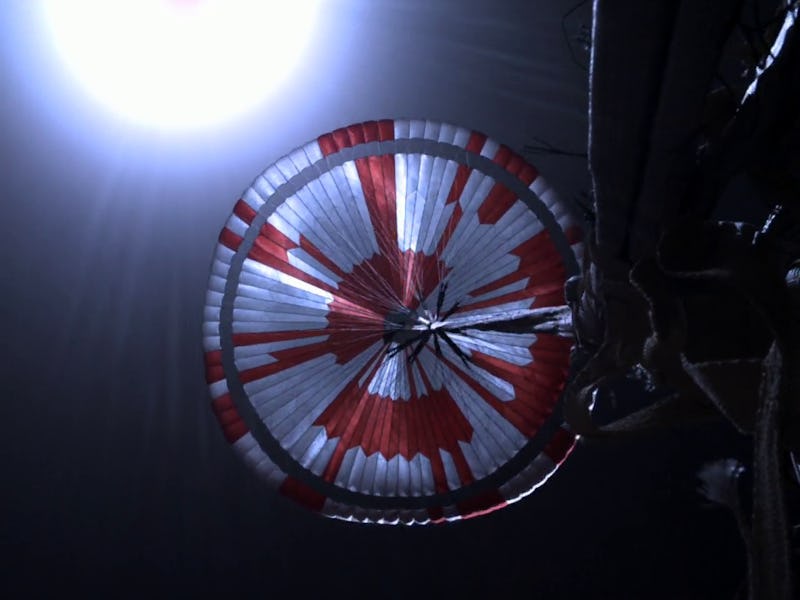Mars 2020 rover landing: 2 NASA easter eggs you missed
The message "dare mighty things" was hidden in plain view. It took a group of internet sleuths to find it.

Sometimes, it's not enough to just land a rover to Mars. NASA added an extra, coded layer to the Perseverance touchdown that was later revealed by the power of the internet.
On Monday, when NASA released a video of the Perseverance rover landing on Mars, team members of the mission hinted at a "secret message" left behind in the touchdown sequence. Within hours, digital detective work cracked the code, revealing that Perseverance's parachute reads "Dare Mighty Things" in binary code.
Perseverance landed on Mars on February 18 after traveling through space for nearly seven months.
Before it touched down on the dusty surface of the Red Planet, Perseverance underwent a series of intricate and terrifying maneuvers known as the "seven minutes of terror."
And for the first time in NASA Mars missions history, the rover was packed with a camera system on the entry, descent, and landing modules that captured the rover's landing sequence in stunning detail.
As seen in the video, the spacecraft deployed a parachute about seven miles above the surface of Mars.
The parachute revealed a pattern in red and white which was later revealed to be a secret code that Perseverance mission engineers had embedded.
“Sometimes we leave messages in our work for others to find for that purpose, so we invite you all to give it shot and show your work," Allen Chen, the entry, descent, and landing lead for Perseverance, said during a press briefing on Monday after indicating that he hopes their work can inspire others.
And Chen's challenge was certainly accepted.
The people of the internet used their detective skills to decode a secret hidden message written in binary code on this parachute.
Amateur investigators on Twitter and Reddit noticed that the pattern on the parachute was likely deliberate, and began dissecting it. They assigned the number one to the red and the number zero to the white, with each of the concentric rings of the parachute representing a word.
By doing so, they were able to read NASA's secret message that was written in binary code on Perseverance's parachute.
The message read, "Dare Mighty Things," a slogan often used by NASA's Jet Propulsion Laboratory (JPL), originating from a 1899 speech by Theodore Roosevelt.
Meanwhile, the outer edge of the parachute is also believed to carry the coordinates 34°11’58” N 118°10’31” W, which is the geolocation code for NASA's Jet Propulsion Laboratory headquarters.
But that wasn't the only secret message that Perseverance carried to the Red Planet.
An image released by NASA of the rover on Mars revealed a tiny family portrait of all the Mars rovers the space agency has fostered over the years.
Perseverance is also carrying three small chips stenciled with 10.9 million names of people who had submitted their names to be honorary passengers to Mars, including actor Brad Pitt. Additionally, the rover is marked with a Covid-19 memorial on the left side of the rover chassis to commemorate the efforts of healthcare workers during the past year.
NASA has sent small messages as part of their missions to Mars in the past. Metal from the wreckage of New York City's Twin Towers on 9/11 was installed on the previous Mars rovers Opportunity and Spirit, and Spirit also carried a memorial to the crew of Space Shuttle Columbia. The Curiosity rover carried a 1909 penny to mark hundredth anniversary of the Lincoln penny. NASA's InSight Mars Lander carried a secret braille code that spells out JPL.
And it doesn't just stop at Mars. NASA has adorned missions to other space destinations with secret messages as well.
The New Horizons spacecraft set out for Pluto with nine secret items, including the ashes of Pluto discoverer Clyde Tombaugh, a CD-ROM with pictures of the mission's team, a 1991 U.S. stamp that read, “Pluto: Not Yet Explored,” and a quarter from the state of Florida, where the mission launched from.
The Juno team engineers packed the spacecraft with these tiny LEGO figures.
Meanwhile, the team behind the Juno spacecraft that headed to Jupiter took a less serious approach and packed three LEGO figurines of the god Jupiter, his wife Juno, and Galileo Galilei, who discovered the four large moons of Jupiter in 1610.
This article was originally published on